Etendue
Etendue or étendue (/ˌeɪtɒnˈduː/; French pronunciation: [etɑ̃dy]) is a property of light in an optical system, which characterizes how "spread out" the light is in area and angle. It corresponds to the beam parameter product (BPP) in Gaussian beam optics.
From the source point of view, it is the product of the area of the source and the solid angle that the system's entrance pupil subtends as seen from the source. Equivalently, from the system point of view, the etendue equals the area of the entrance pupil times the solid angle the source subtends as seen from the pupil. These definitions must be applied for infinitesimally small "elements" of area and solid angle, which must then be summed over both the source and the diaphragm as shown below. Etendue may be considered to be a volume in phase space.
Etendue never decreases in any optical system where optical power is conserved.[1] A perfect optical system produces an image with the same etendue as the source. The etendue is related to the Lagrange invariant and the optical invariant, which share the property of being constant in an ideal optical system. The radiance of an optical system is equal to the derivative of the radiant flux with respect to the etendue.
The term étendue comes from the French étendue géométrique, meaning "geometrical extent". Other names for this property are acceptance, throughput, light grasp, light-gathering or -collecting power, optical extent, geometric extent, and the AΩ product. Throughput and AΩ product are especially used in radiometry and radiative transfer where it is related to the view factor (or shape factor). It is a central concept in nonimaging optics.[2][3][4]
Definition
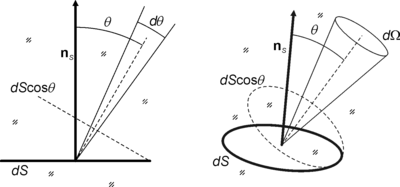
An infinitesimal surface element, dS, with normal nS is immersed in a medium of refractive index n. The surface is crossed by (or emits) light confined to a solid angle, dΩ, at an angle θ with the normal nS. The area of dS projected in the direction of the light propagation is dS cos θ. The etendue of this light crossing dS is defined as
Because angles, solid angles, and refractive indices are dimensionless quantities, etendue has units of area (given by dS).
Conservation of etendue
As shown below, etendue is conserved as light travels through free space and at refractions or reflections. It is then also conserved as light travels through optical systems where it undergoes perfect reflections or refractions. However, if light was to hit, say, a diffuser, its solid angle would increase, increasing the etendue. Etendue can then remain constant or it can increase as light propagates through an optic, but it cannot decrease. This is a direct result of increasing entropy, which only can be reverted if a priori knowledge is used to reconstruct a phase-matched wave-front such as with phase conjugated mirrors.
Conservation of etendue can be derived in different contexts, such as from optical first principles, from Hamiltonian optics or from the second law of thermodynamics.[2]
In free space
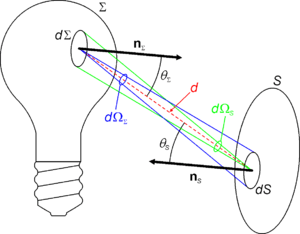
Consider a light source Σ, and a light detector S, both of which are extended surfaces (rather than differential elements), and which are separated by a medium of refractive index n that is perfectly transparent (shown). To compute the etendue of the system, one must consider the contribution of each point on the surface of the light source as they cast rays to each point on the receiver.[5]
According to the definition above, the etendue of the light crossing dΣ towards dS is given by:
where dΩΣ is the solid angle defined by area dS at area dΣ. Similarly, the etendue of the light crossing dS coming from dΣ is given by:
where dΩS is the solid angle defined by area dΣ. These expressions result in
showing that etendue is conserved as light propagates in free space.
The etendue of the whole system is then:
If both surfaces dΣ and dS are immersed in air (or in vacuum), n = 1 and the expression above for the etendue may be written as
where FdΣ→dS is the view factor between differential surfaces dΣ and dS. Integration on dΣ and dS results in G = πΣ FΣ→S which allows the etendue between two surfaces to be obtained from the view factors between those surfaces, as provided in a list of view factors for specific geometry cases or in several heat transfer textbooks.
The conservation of etendue in free space is related to the reciprocity theorem for view factors.
In refractions and reflections
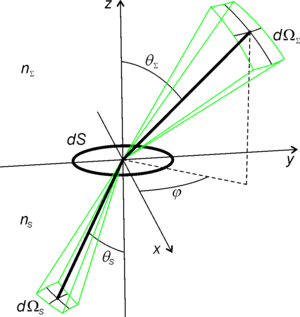
The conservation of etendue discussed above applies to the case of light propagation in free space, or more generally, in a medium in which the refractive index is constant. However, etendue is also conserved in refractions and reflections.[2] Figure "etendue in refraction" shows an infinitesimal surface dS on the xy plane separating two media of refractive indices nΣ and nS.
The normal to dS points in the direction of the z axis. Incoming light is confined to a solid angle dΩΣ and reaches dS at an angle θΣ to its normal. Refracted light is confined to a solid angle dΩS and leaves dS at an angle θS to its normal. The directions of the incoming and refracted light are contained in a plane making an angle φ to the x axis, defining these directions in a spherical coordinate system. With these definitions, Snell's law of refraction can be written as
and its derivative relative to θ
multiplied by each other result in
where both sides of the equation were also multiplied by dφ which does not change on refraction. This expression can now be written as
and multiplying both sides by dS we get
that is
showing that the etendue of the light refracted at dS is conserved. The same result is also valid for the case of a reflection at a surface dS, in which case nΣ = nS and θΣ = θS.
Conservation of basic radiance
Radiance of a surface is related to étendue by:
where
- is the radiant flux emitted, reflected, transmitted or received;
- n is the refractive index in which that surface is immersed;
- G is the étendue of the light beam.
As the light travels through an ideal optical system, both the étendue and the radiant flux are conserved. Therefore, basic radiance defined as:[6]
is also conserved. In real systems, the étendue may increase (for example due to scattering) or the radiant flux may decrease (for example due to absorption) and, therefore, basic radiance may decrease. However, étendue may not decrease and radiant flux may not increase and, therefore, basic radiance may not increase.
Etendue as a volume in phase space
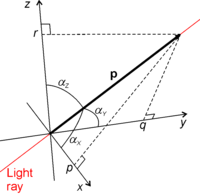
In the context of Hamiltonian optics, at a point in space, a light ray may be completely defined by a point r = (x, y, z), a unit Euclidean vector v = (cos αX, cos αY, cos αZ) indicating its direction and the refractive index n at point r. The optical momentum of the ray at that point is defined by
where ||p|| = n. The geometry of the optical momentum vector is illustrated in figure "optical momentum".
In a spherical coordinate system p may be written as
from which
and therefore, for an infinitesimal area dS = dx dy on the xy plane immersed in a medium of refractive index n, the etendue is given by
which is an infinitesimal volume in phase space x, y, p, q. Conservation of etendue in phase space is the equivalent in optics to Liouville's theorem in classical mechanics.[2] Etendue as volume in phase space is commonly used in nonimaging optics.
Maximum concentration
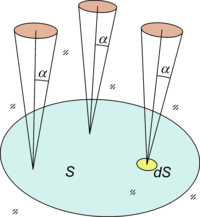
Consider an infinitesimal surface dS, immersed in a medium of refractive index n crossed by (or emitting) light inside a cone of angle α. The etendue of this light is given by
Noting that n sin α is the numerical aperture NA, of the beam of light, this can also be expressed as
Note that dΩ is expressed in a spherical coordinate system. Now, if a large surface S is crossed by (or emits) light also confined to a cone of angle α, the etendue of the light crossing S is

The limit on maximum concentration (shown) is an optic with an entrance aperture S, in air (ni = 1) collecting light within a solid angle of angle 2α (its acceptance angle) and sending it to a smaller area receiver Σ immersed in a medium of refractive index n, whose points are illuminated within a solid angle of angle 2β. From the above expression, the etendue of the incoming light is
and the etendue of the light reaching the receiver is
Conservation of etendue Gi = Gr then gives
where C is the concentration of the optic. For a given angular aperture α, of the incoming light, this concentration will be maximum for the maximum value of sin β, that is β = π/2. The maximum possible concentration is then[2][3]
In the case that the incident index is not unity, we have
and so
and in the best-case limit of β = π/2, this becomes
If the optic were a collimator instead of a concentrator, the light direction is reversed and conservation of etendue gives us the minimum aperture, S, for a given output full angle 2α.
References
- Lecture notes on Radiance
- Chaves, Julio (2015). Introduction to Nonimaging Optics, Second Edition. CRC Press. ISBN 978-1482206739.
- Roland Winston et al.,, Nonimaging Optics, Academic Press, 2004 ISBN 978-0127597515
- Matthew S. Brennesholtz, Edward H. Stupp, Projection Displays, John Wiley & Sons Ltd, 2008 ISBN 978-0470518038
- Wikilivre de Photographie, Notion d'étendue géométrique (in French). Accessed 27 Jan 2009.
- William Ross McCluney, Introduction to Radiometry and Photometry, Artech House, Boston, MA, 1994 ISBN 978-0890066782
Further reading
| Wikimedia Commons has media related to Etendue. |
| Look up etendue in Wiktionary, the free dictionary. |
- Greivenkamp, John E. (2004). Field Guide to Geometrical Optics. SPIE Field Guides vol. FG01. SPIE. ISBN 0-8194-5294-7.
- Xutao Sun et al., 2006, "Etendue analysis and measurement of light source with elliptical reflector", Displays (27), 56–61.
- Randall Munroe explains why it's impossible to light a fire with concentrated moonlight using a etendue-conservation argument. Munroe, Randall. "Fire from Moonlight". What If?. Retrieved 28 July 2020.